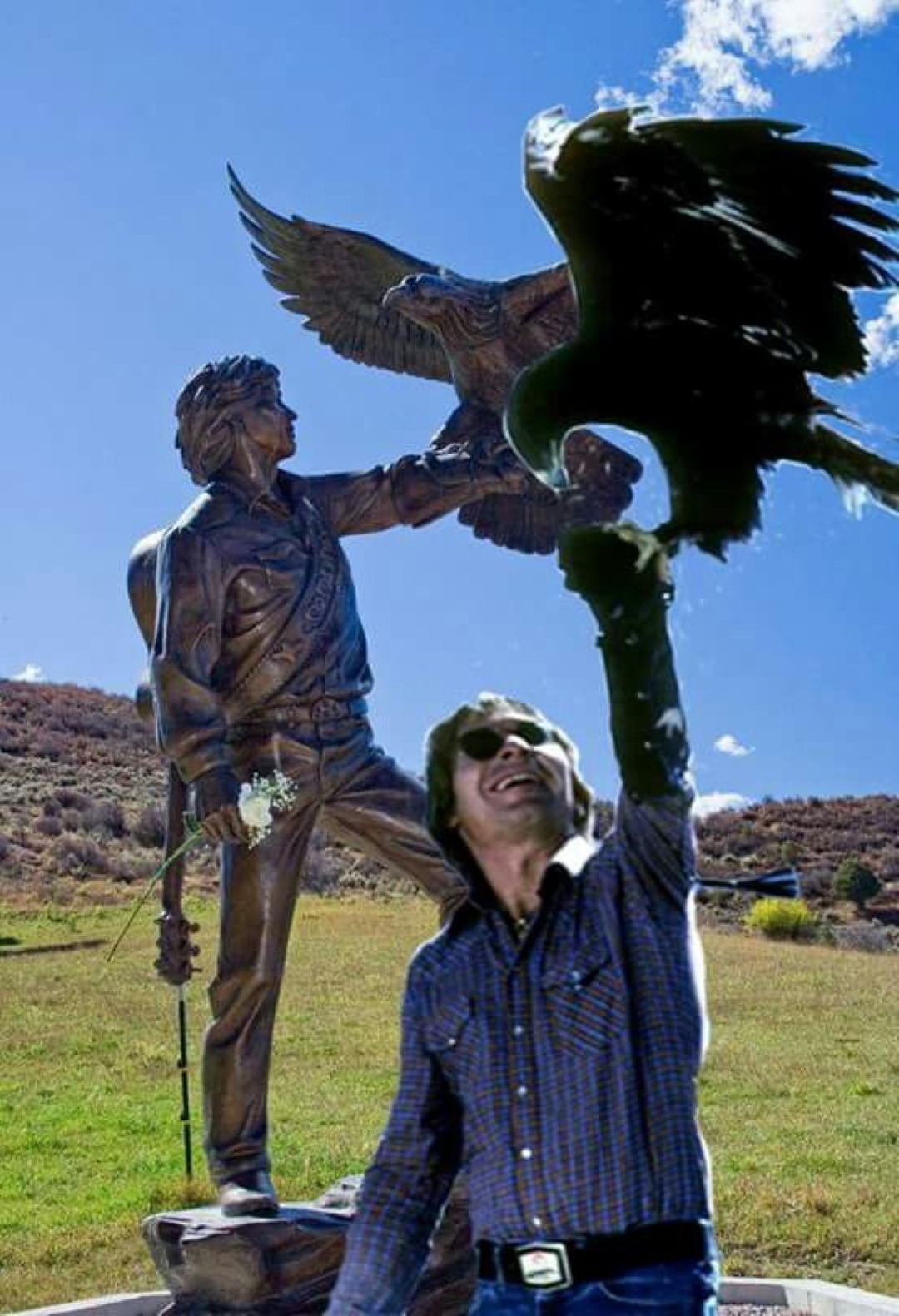When you step into the Colorado Music Hall of Fame, there’s one sight that instantly draws your eyes: a bronze sculpture of John Denver, his face lifted slightly upward, a gentle smile crossing his features, and beside him — an eagle in mid-flight. The statue, titled “Spirit”, captures something beyond just the likeness of a man. It embodies the essence of what John Denver stood for — freedom, nature, peace, and the boundless connection between humanity and the Earth.

🌄 The Making of “Spirit”
Created by sculptor Sue DiCicco, “Spirit” was unveiled as a heartfelt tribute to John Denver — not just as a musician, but as a cultural force who gave voice to nature and the human soul. The process took over a year, as DiCicco studied thousands of photos, concert videos, and interviews to understand the warmth and inner light Denver carried wherever he went.
She said later in an interview:
“I didn’t just want to sculpt John Denver. I wanted to sculpt what he made people feel.”
The final piece shows Denver gazing forward with serene optimism, while an eagle spreads its wings beside him — symbolizing freedom, hope, and the vastness of the skies he sang about. Every detail was intentional: the gentle folds of his shirt, the openness of his expression, and the way the eagle’s wings curl around him like a spirit guide.
🌿 Why an Eagle?
For Denver, the eagle wasn’t just a national symbol — it was a reflection of his own values. In songs like “Eagles and Horses (I’m Flying Again)” and “Windsong”, the imagery of flight, sky, and open land appears over and over. The eagle represented the freedom he felt whenever he was close to nature, whether hiking in the Rockies or flying one of his beloved planes.
Sue DiCicco chose the eagle to symbolize that “spirit of flight” — both literal and emotional — that defined Denver’s life. Even after his tragic plane crash in 1997, the image of flight remains deeply tied to his legacy. “Spirit,” therefore, becomes not just a memorial but a continuation of that flight.
The statue invites you to look up — the same way John always encouraged his listeners to do — toward the sky, toward hope, toward something larger than ourselves.
🎶 A Place Among Legends
At the Colorado Music Hall of Fame, the “Spirit” statue stands proudly among other tributes to the state’s most influential artists. Yet none feel quite as intimate.
Denver was more than a local hero — he was the soul of Colorado. His songs turned the mountains, rivers, and endless skies into poetry. When you stand before “Spirit,” you don’t just see a statue. You feel the thin, clean air of the Rockies, the sound of a guitar echoing across the hills, and the timeless melody of “Rocky Mountain High.”
Visitors often leave flowers, handwritten notes, or small stones at the base of the sculpture — an organic, living tribute to a man who saw nature as sacred.
✨ A Legacy Beyond Music
“Spirit” isn’t just about remembering John Denver’s music — it’s about remembering his message.
Throughout his career, Denver was an environmentalist long before it became fashionable. He founded the Windstar Foundation, campaigned for renewable energy, and spoke at the U.S. Senate about conservation and the human duty to protect the planet.
To him, songs like “Calypso” and “Earth Day Every Day” were more than melodies; they were manifestos. He believed music could change minds — that it could reconnect people with the Earth, with kindness, and with each other.
“Spirit” distills all of that into bronze — eternal, unchanging, yet alive with movement.
🌤️ The Meaning of “Spirit”
Standing before the statue, you can’t help but feel its quiet energy. The eagle’s wings are mid-motion — suggesting flight, not rest. John’s eyes look toward an unseen horizon, as if he’s about to take off once more.
It’s fitting, then, that the statue was named “Spirit.”
Because spirit, in Denver’s world, was everything:
-
The spirit of the land that nurtures.
-
The spirit of people who dream and love.
-
The spirit that never truly dies, even when the body is gone.
In that sense, “Spirit” doesn’t mourn John Denver — it celebrates him. It reminds the world that his ideals are still in the air we breathe, in every mountain breeze, in every person who hums “Take Me Home, Country Roads” while driving through an open road at sunset.
🦅 A Song That Captures It All: “Spirit” (1975)
Of all his works, perhaps the song “Spirit” from his 1975 album Windsong mirrors this sculpture the most. It’s a meditative, uplifting piece — half prayer, half anthem — that speaks to the invisible thread connecting all living things.
“Spirit, it’s a dreamer’s dream, your gentle touch upon my life…
Lifted me above the pain, and I’m flying free again.”
Hearing it today feels prophetic — as if Denver knew his life would become a symbol of peace and transcendence. When paired with the bronze “Spirit,” the song feels less like a melody and more like a continuation — a soundtrack to the sculpture’s silent motion.
🌈 The Eternal Flight
Nearly three decades after his passing, “Spirit” remains a pilgrimage spot for fans. People come from all over the world — not only to remember Denver but to find a moment of peace. Children run around the statue. Couples pose for photos. Musicians play his songs nearby during tribute events.
And sometimes, a single eagle circles overhead — a coincidence, perhaps, but one that feels like poetry.
In that quiet, bronze shimmer under the Colorado sun, John Denver’s essence lives on.
Not as a ghost, but as a presence.
Not as an absence, but as a flight.
Because the spirit of John Denver was never meant to rest.
It was meant to soar.